The best coffee grinder
The Baratza Encore is the best option for most people.

By Liz Clayton
This post was done in partnership with Wirecutter. When readers choose to buy Wirecutter's independently chosen editorial picks, Wirecutter and Engadget may earn affiliate commission. Read the full mirrorless camera for beginners guide here.
After over 70 hours of research and hands-on grinding since 2015, we think the uber-consistent, no-frills Baratza Encore is the best grinder for most people. At a practical price, it reliably delivers the high-quality grind needed to make a great cup of drip or French press coffee.
The Baratza Encore grinds coffee more evenly than almost any other machine we tested on a wide range of settings. It's a reliable, straightforward tool—there's almost no learning curve—that takes up only a modest square of counter space. It's also super easy to clean and maintain, meaning it'll be an investment you can rely on morning after morning. While it can't produce a fine enough grind for serious espresso enthusiasts, its output is consistent enough for a serviceable shot and should satisfy anyone's filter coffee needs.
The Baratza Virtuoso is a great grinder with a speedy, durable burr set and consistent grinding performance. It looks and feels solid, and unlike the Encore, it has a timer switch that makes it easy to grind the exact same amount of coffee each time you brew. It also has a sturdier base than the Encore, which helps keep burrs from vibrating out of calibration, making it more convenient for those who drink a lot of coffee and still demand consistent results. But though the Virtuoso grinds a little faster, its grind is not significantly better than the Encore's—you're paying for incremental improvements.
Though it isn't cheap, the OXO Brew Conical Burr Grinder is the best grinder we've found in its price range. So long as you mainly drink drip or French press coffee, the OXO's relatively even grind, wide range of settings, and ease of use make it a good alternative if you can't afford the Baratza Encore, which still offers a more consistent, versatile grind. It's also got some nice features, like a mechanism to reduce static when grinding and a hopper you can remove to change out beans easily—something we still wish Baratza offered.
While we stress that hand grinders should be recognized for what they are—good machines to use when electricity is not available rather than cheaper alternatives to electric burr grinders—the Porlex was easily our favorite. Its grinding action is smooth and easy on the hand and wrist, and the grinder itself is durable and compact—it even stows away in the cylinder of an AeroPress if you are traveling. But remember, hand grinders can only make enough grounds for a cup or two of coffee at a time, and that can take 5-10 minutes of manual labor.
Why you should trust us
I'm a coffee writer with plenty of experience grinding and brewing coffee with all levels of professionals. I'm also the associate editor for the coffee news website Sprudge and have published coffee grinder guides and articles about coffee equipment there and elsewhere. For even more in-depth expertise, we conducted our testing at Counter Culture Coffee's New York City training center, tapping the wisdom (and palates) of two of its staff, Matt Banbury and Ryan Ludwig, to fine-tune our testing criteria and evaluate each grinder. Other experts we enlisted for advice included Scott Rao, whose many books on brewing and coffee roasting reflect his deep investment in figuring out exactly the best way to do anything whatsoever involving coffee, and Kyle Ramage, the 2017 United States Barista Champion, who previously worked for many years at leading international commercial coffee-grinder manufacturer Mahlkönig.
Our research also builds on the work of Cale Guthrie Weissman, who wrote the previous version of this guide and spent over 40 hours researching and testing grinders. For this update, we spent weeks researching new grinders (and re-researching old favorites). We looked at new reviews from Home Grounds and Business Insider, and we took into account recommendations for budget-category entries as well as some longevity complaints about other grinders from within Wirecutter staff.
Who this is for
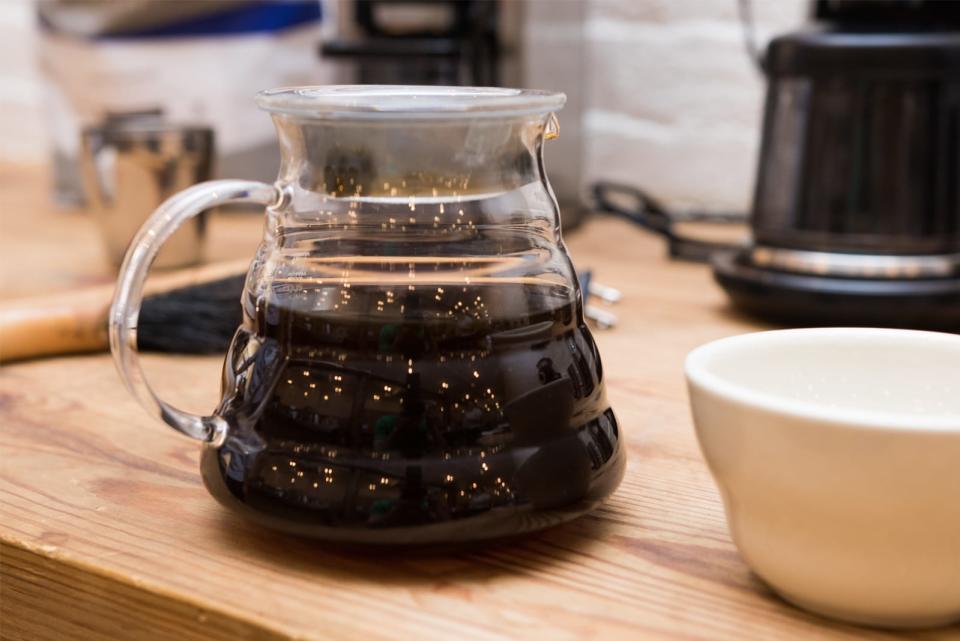
If you consider your morning (or afternoon, or anytime) coffee a serious matter, you've likely already heard that the most important item in your brewing setup is a quality burr grinder. Unevenly ground coffee will brew unevenly, yielding a muddied or overly bitter cup. So a good grinder is integral to keeping the most essential part of your brewing technique—the coffee itself—at its most flavorful, and it will ensure the consistency required to produce and reproduce that flavor.
A good grinder will turn an alright coffee routine into a great coffee routine. If you're currently brewing pre-ground coffee (which is quickly going stale from the minute it's ground), or using a subpar grinder (especially a budget, blade-style grinder), switching to a reliable burr grinder will significantly improve the flavor of your cup. Drinking coffee brewed from fresh, properly ground coffee, you'll quickly detect the difference in aromatics, flavor, sweetness, acidity, dimension, and body.
A burr grinder also allows for a broad choice of brewing devices and types of coffee: It can grind coarsely enough for a good French press or cold-brew batch but also nails a medium grind for drip. Whether you make coffee at home once a day or once an hour, whether you brew with a Hario V60 and a precision scale or just dump it all into a French press carafe or an automatic drip basket, and whether you buy your whole beans at the grocery store or order them direct from Norway, how well your grinder performs will have a tremendous effect on the end brew.
A good grinder will turn an alright coffee routine into a great coffee routine.
Note, however, that the one thing the grinders in this guide aren't great for is espresso. They'll grind your coffee fine enough for a passable shot, but to make the best espresso, you'll need to pay more for a machine with finer, more precise settings. We have recommendations in our guide to espresso machines and gear, but they're worth the extra $200 to $300 only if you're serious about making espresso at home.
Burr grinders vs. blade grinders
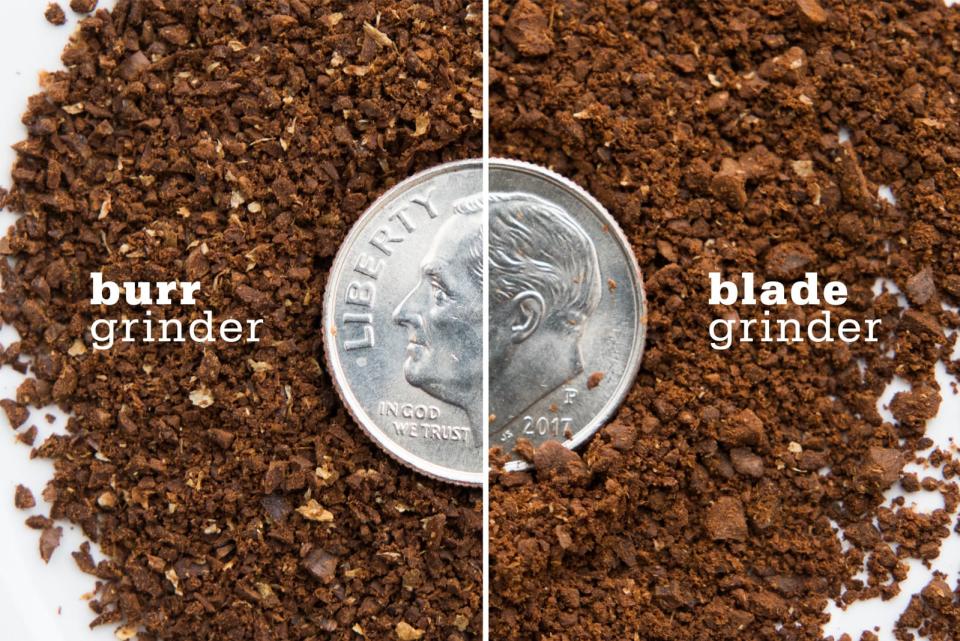
Unlike blade grinders, which randomly chop coffee beans into smaller and smaller pieces, burr grinders pulverize coffee beans between two sets of burrs. The space between the two burrs determines the final size of the coffee grounds, so the grounds end up a much more consistent size than anything buzzed in a blade grinder.
All burr grinders will still include some smaller and larger particles than the intended result, but good ones will include fewer of them. "Much like when you cut crusty bread, when you shatter coffee beans there are always going to be some small particles," explains coffee writer and researcher Scott Rao. "There are going to be dusty little particles we call fines, and there's going to be some larger particles we call boulders, and a whole bunch of particles in the middle that are going to be the size you want."
The fewer fines and boulders in your coffee grounds, the more even—and therefore better—the brew will taste. "The problem with fines is that all of their coffee solids are on the outer surface and 100 percent exposed to the water," says Rao, "You will get over-extraction in seconds from a fine...because there's no water going into the grounds, dissolving stuff, and getting out, it's all just washing stuff off the surface instantly—you'll taste a lot of tannins, astringency, and bitterness." Boulders, on the other hand, are less of a problem, but they slow down overall extraction—meaning weaker coffee. "In and of themselves, they may not cause bad flavors," says Rao, "but their extraction is very slow, so the more boulders you have, extraction drops a lot."
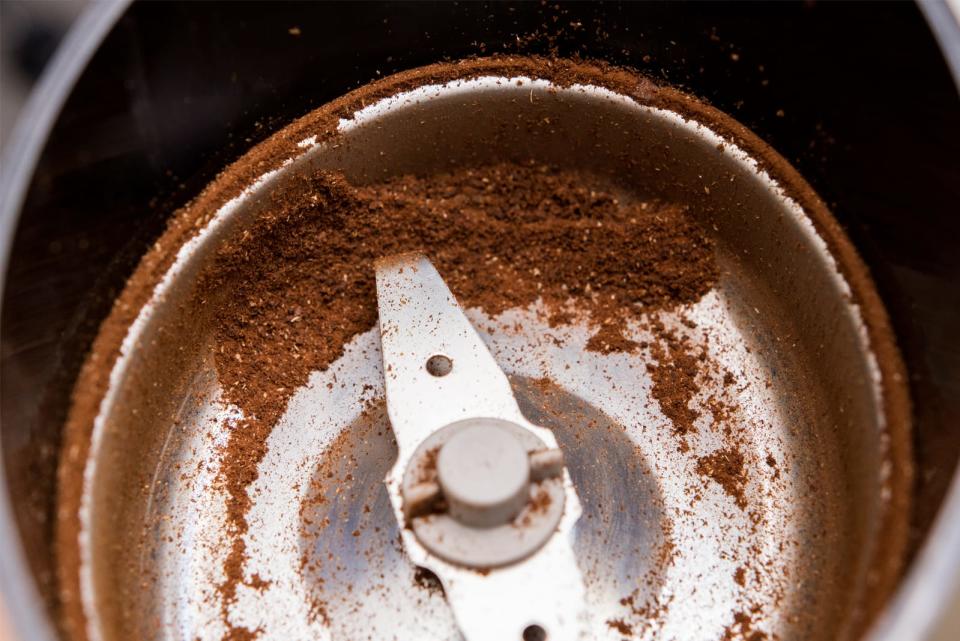
A blade grinder will produce worse coffee than a burr grinder because it has no way to set a desired particle size. It simply spins around and around until it's made most of the pieces smaller, and it yields many more fines and boulders than a grinder that uses burrs. With blade grinders, you get coffee that's an unpleasant mixture of overextracted (more bitter) and underextracted (more sour), with most of the agreeable middle notes submerged.
Burr grinders deliver a much more uniform grind than blade grinders. It's this consistency that allows you to instead focus on other variables such as dose weight, brewing time, and whether or not you really enjoy Indonesian coffees in order to perfect your home routine.
The fewer fines and boulders in your coffee grounds, the more even—and therefore better—the brew will taste.
We found the leap in great taste from a bad grinder to a good grinder to be noticeable to even the casual coffee drinker who participated in our testing, and we've heard the same thing from other Wirecutter staffers who made the switch to a burr grinder. (We could be more insistent about all this, too, but think the results speak for themselves.) Grinder veteran Kyle Ramage says: "Grind particle distribution is much more important than grinding fresh. If you use a really bad grinder at home, you're not going to get the expression of that coffee even close to what you'd get at the cafe. Grinding it at the cafe and bringing it home is still better than using one of those whirlybird, weed-whacker grinders."
Good burr grinders cost significantly more than a standard $20 blade grinder, but the flavor difference makes it worth the upgrade for those who enjoy coffee.
How we picked
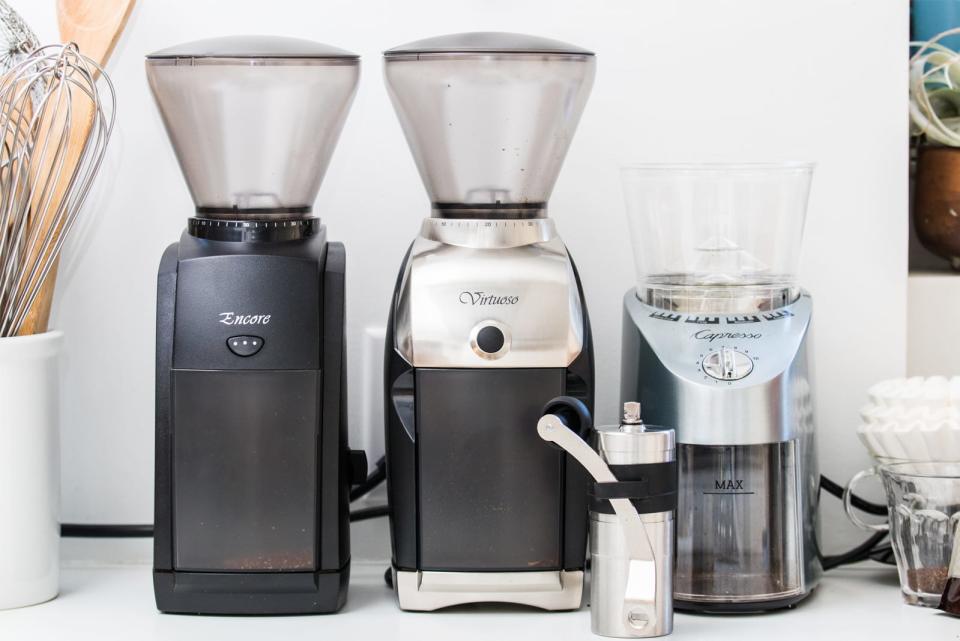
A quality grinder will necessarily cost you at least $100, which is one reason so many coffee lovers linger in the purgatory of affordable, substandard blade-grinder-land. But a good grinder should justify the price: It should last for years with proper maintenance and be simple to operate, maintain, and clean. When these stars all line up, the return on investment (whether it's more cups at home instead of bought out of the house, fewer crappy grinders needing to be replaced over the years, or simply a higher quality of coffee) should be well worth it for most passionate coffee drinkers.
When researching and testing grinders, we prioritized grind-size consistency as the number one thing good grinders do right. It's the most important feature if you want to get the most even, balanced extraction with every brew. From there, we sought out a variety of other grinder features, ranging from the essential to the nice-to-have:
Quality burrs
Every grinder crushes beans between two burrs, but not all burr sets are created equal. They can be made of steel, ceramic, or even plastic (not ideal). Durable burrs made of material like steel last over time and are easy to maintain and clean with a stiff brush. Steel burrs are less expensive to produce and thus are more common, while ceramic burrs are harder and dull more slowly. Some burrs are conical while others are flat. A conical burr shape grinds coffee evenly enough for the home user and—experts say—collects less coffee between the burrs than a flat one, making it easier to clean.
Clear grind settings
We looked for grinders with clearly marked grind settings, since those who brew coffee regularly will want to easily repeat the optimal settings for their daily brew. While most coffee grinders will have a range of size selection from finest (theoretically, but not necessarily, espresso grind) to coarsest (for French press or steeping cold brew), not all grinders offer visual clues about where on the spectrum other brew methods might fall. (A nice medium grind setting for a cup of filter coffee may or may not fall exactly between the finest and the coarsest grind.) Such clues are helpful but not essential. More importantly, the steps between each incremental grind size should be clear and consistent so that you can make adjustments easily as you dial in the perfect setting for your particular coffee and brewing device.
Dosage measurements
Grinders with preset dose measurements allow you to easily grind the same amount of coffee each time. Some grinders come with integrated scales, which are the most precise way to measure how much coffee you've ground. Other machines work on a timer, so you can set them to grind for, say, 30 seconds, yielding about the same amount of ground coffee each time. Still others will grind preset dosage amounts, roughly based on how many cups of coffee they'll yield (sometimes you can also program your own dose presets). Machines without these timers or presets require you to time the grind duration yourself and turn of the machine at the right moment, or to weigh or measure out the resulting coffee after the fact. (If you need a scale, we recommend the American Weigh Scales LB-3000 for precise coffee measurements.) While it's nice not to have to take that extra step, it's also not a huge inconvenience to do so, and we tested machines both with and without dosage measurements.
Cleaning and maintenance
To properly maintain your grinder, it's essential to be able to clean inside the burr chamber (especially if you have a taste for oiler, darker-roasted, or even-flavored coffees, which will leave residue you want to remove for flavor and grinder performance). Most of the machines we tested had easily-removable burr sets to allow for regular cleaning and, when the time is right, replacement. Ease of cleanup around the machine is important too, especially if a grinder is particularly naughty about spraying chaff everywhere. A little bit of mess is normal—and can depend on the type of coffee you grind and the level of humidity in your home—but not a lot.
With all the above criteria in mind, we narrowed down our list of electric burr grinders to test in 2017. Despite long-term love for the Baratza line, both in terms of performance and customer support, we were eager to know what else had come out in the two years since our last test. Additionally, we really wanted to find some more affordable grinders out there, since $100 as an entry-level price is a tough sell for anyone who doesn't consider themselves a major coffee geek. Ultimately, we brought back our top pick and runner-up from last time, the Baratza Virtuoso and the Baratza Encore, as well as our former budget pick, the Capresso Infinity, plus the OXO On Conical Burr Grinder (also called the Barista Brain) and the Breville SmartGrinder Pro. We also added in the Cuisinart CBM-20N (their highest-quality grinder) and tested the popular Krups GX5000 to see if it's possible for a $50 grinder to hold up against the big (ticket) guys. In fall of 2018, we also tested the affordable OXO Brew Conical Burr Grinder against our picks.
What about hand grinders?
Because someone will always chime in with the question, "Can't I just buy a much more affordable hand grinder?" we tested a couple of those as well: the Porlex Mini and the Hario Mini Mill Slim. I don't ever believe that people will really want to hand grind their coffee every morning like they tell themselves when they're making this purchase—it takes ages of manual cranking, during which you're wasting precious morning minutes while the dog is barking, the baby is crying, and you lack caffeine. That said, these grinders are great for travel, with the Porlex even fitting conveniently into the tube of an AeroPress for that coffee geek on the go.
For the two hand grinders we tested, we prioritized speed of grinding and ease of use over all else, since even the best hand grinder is likely to become frustrating to operate day after day, or worse, cup after cup for a thirsty group. While it should have been the most important, ease of grind-size adjustment came second to this, since even the easiest-to-dial-in hand grinder will be a no-go if it takes four minutes to manually grind for one cup of coffee.
How we tested
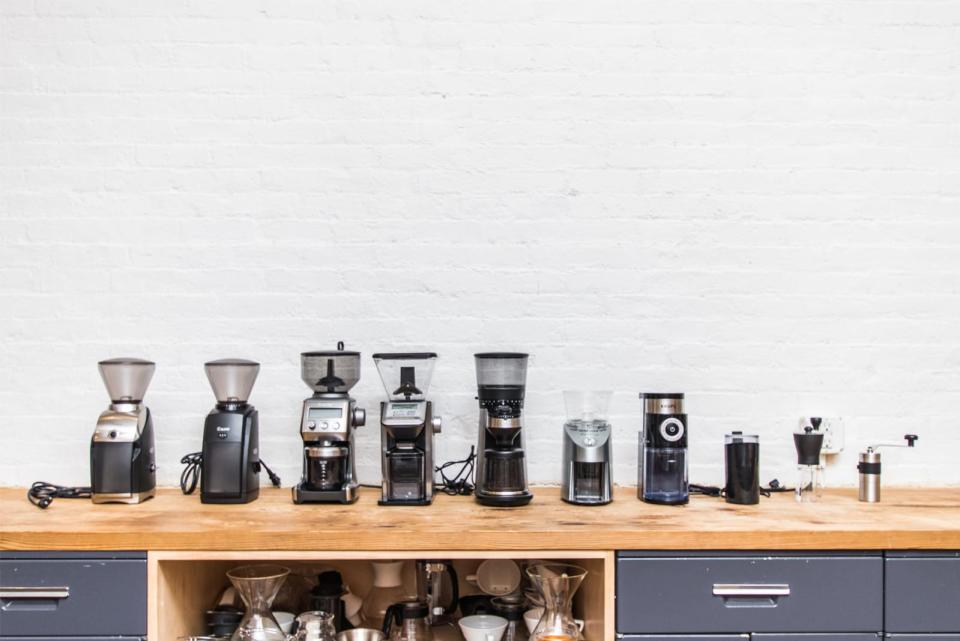
We tested the grinders in a rigorous setting (with access to professional palates and a suite of brewing and analytical equipment), taking over the Counter Culture Coffee lab in Manhattan. Counter Culture pros Matt Banbury and Ryan Ludwig helped us grind, brew, and taste one of their staple coffees, the Fast Forward blend, and measured how well the coffee extracted from the grounds using professional tools.
To find the right grind setting on each machine for brewing, and to test for grind-size consistency, we used Kruve coffee sieves, specially invented to help coffee professionals eliminate under-ground "boulder" coffee particles and over-ground "fines." The Kruve is a set of stacked screens that separate coffee pieces at the target grind size (in our case, the ideal size for the drip coffee machine we used) from any irregular particles. When we arrived at the grind setting that had the most target-sized particles and least overs and unders, we stayed on that setting for our brew test.
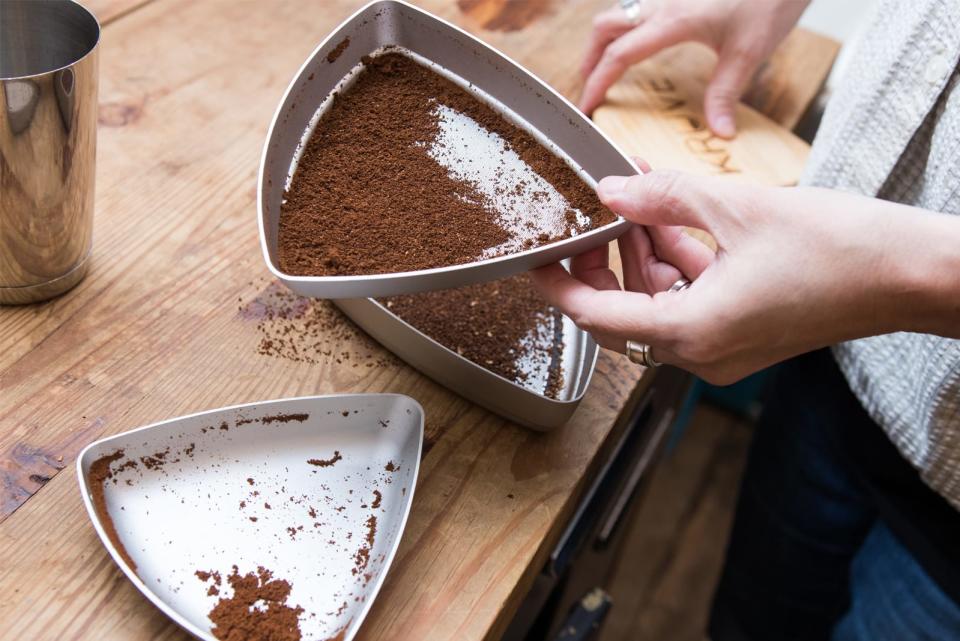
During the grinding process, we timed how fast each grinder performed at different settings as well as how easy each was to use and clean. We also paid attention to ancillary issues like whether the machines were noisy or made a huge mess on the countertop, and we kept an eye out for potential durability issues or weaknesses in workmanship as well.
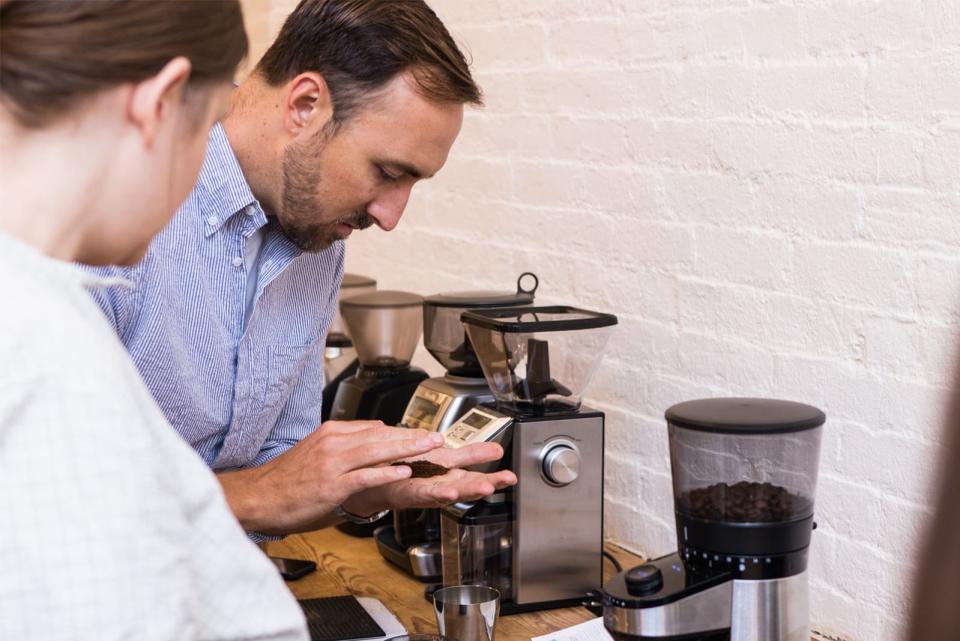
Then we brewed coffee from each grinder on an 8-cup Bonavita BV1900TS brewer (an older version of the runner-up in our guide to coffee makers). After tasting each coffee for a balanced, delicious brew that fell in line with what the Counter Culture team expected of Fast Forward, we used a refractometer to measure the extraction percentage (essentially, how much coffee you get from the coffee grounds). This measurement let us know how much of the coffee was dissolved into the water, and thus how successful the extraction of the grinds was. A well-extracted cup of coffee should measure at between 18 to 22 percent extraction on a refractometer, says Counter Culture's Matt Banbury. For their Fast Forward coffee, the team found it tasted best when results measured between 19.5 and 20.5 percent.
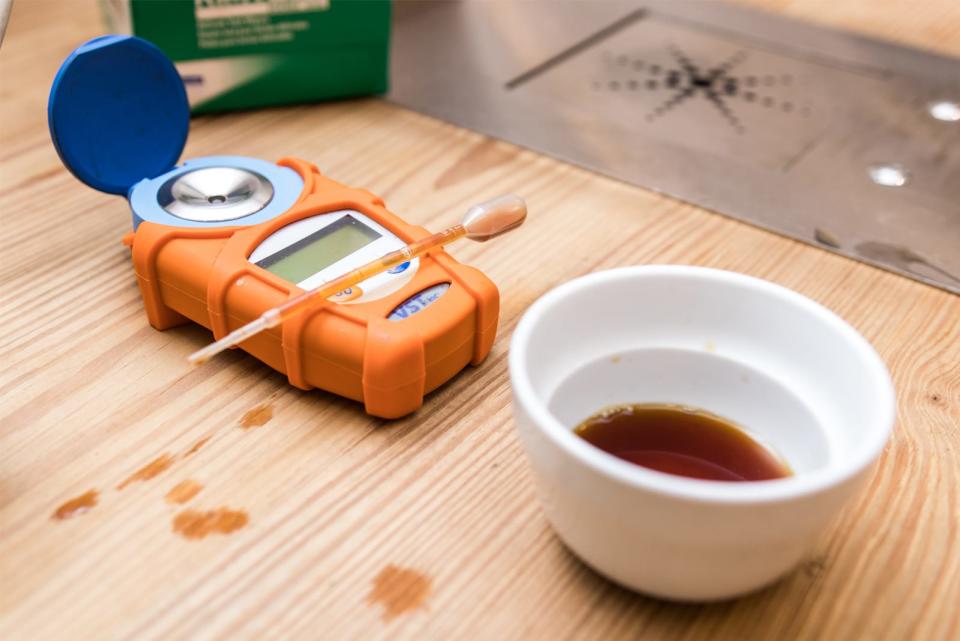
We also used the refractometer to measure the Total Dissolved Solids (TDS) of each brew. TDS, explains Counter Culture's Banbury, is a helpful way to measure how many solids are in a solution based on the light refracted by the particles within. For the purposes of our testing, it provided a useful guidepost for evaluating the grind quantitatively as well as qualitatively. But it's not necessarily a be-all-end-all decider when evaluating coffee, says Banbury. "Presently, there is no tool on the consumer market capable of substituting for a developed palate when it comes to coffee extraction. Tasting the difference between over- and under-extraction remains the best tool for 'dialing in' a brewing recipe."

For sport, we also compared the grinds from a professional-grade Mahlkönig EK43 grinder (price at the time of writing: $2,700), the grinder of record for filter coffee preparation in specialty cafes at present. We evaluated the EK's grinds visually and used the Kruve sifters to see which home machine could best replicate its workhorse consistency. We also ground coffee with a simple Krups blade grinder to see what the opposite end of the spectrum looked like.
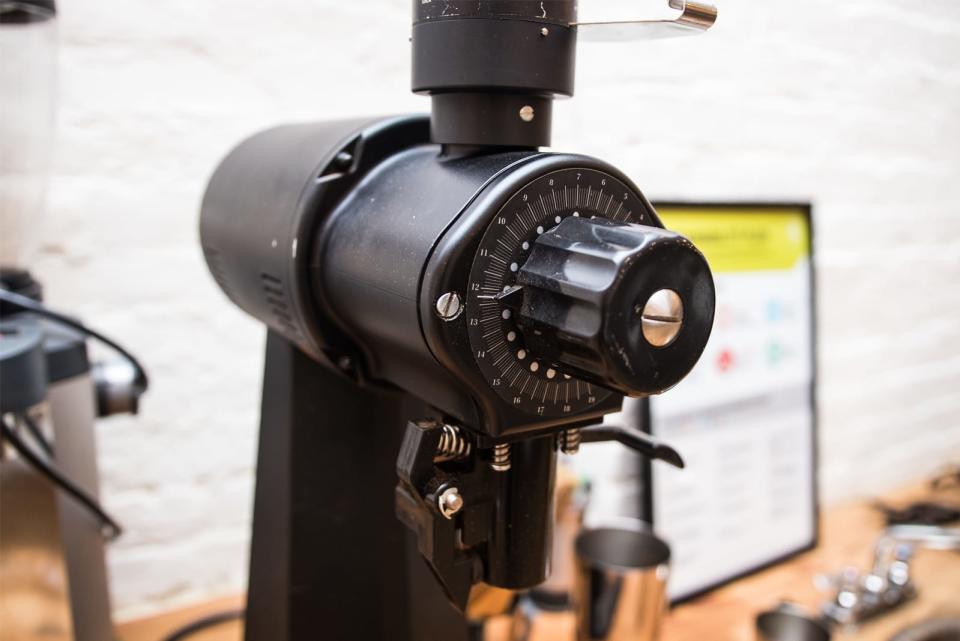
Finally, we tested some of our top models for a few hours in a home setting to focus on more real-world conditions (footprint, noise, ease of use, and speed). For many people, making the leap from a small blade grinder you can stash in the kitchen cupboard between uses and a $100-200 device that will demand counter space is no small upgrade. We kept in mind what features would make a grinder more or less desirable to have as a part of one's regular kitchen counter setup. And to appease the off-the-grid set, we tested two hand grinders as well, timing how long it took to grind enough coffee to make a cup and analyzing the particle-size distribution of the grounds.
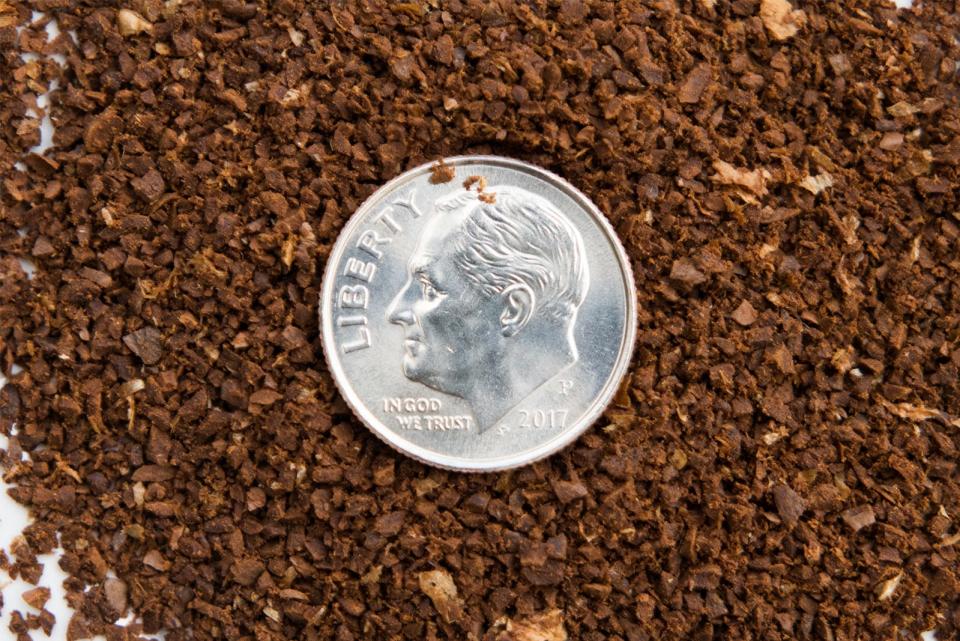
When updating our guide in 2018, we were eager to see how OXO's new and more wallet-friendly burr grinder would perform. In a scaled-down version of our 2017 test, we ran the new OXO Brew Conical Burr Grinder up against our top pick, the Baratza Encore, and our previous budget pick, the Capresso Infinity. We measured the consistency of each grinder's particle output using a Kruve sifter, visually compared the grind size, and brewed and tasted loads of coffee.
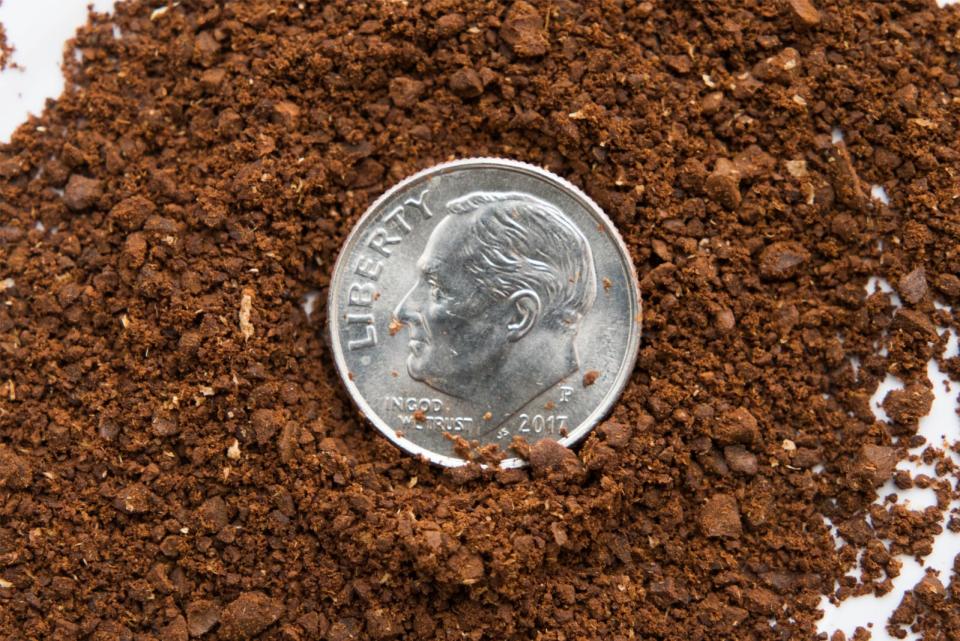
Our pick: Baratza Encore
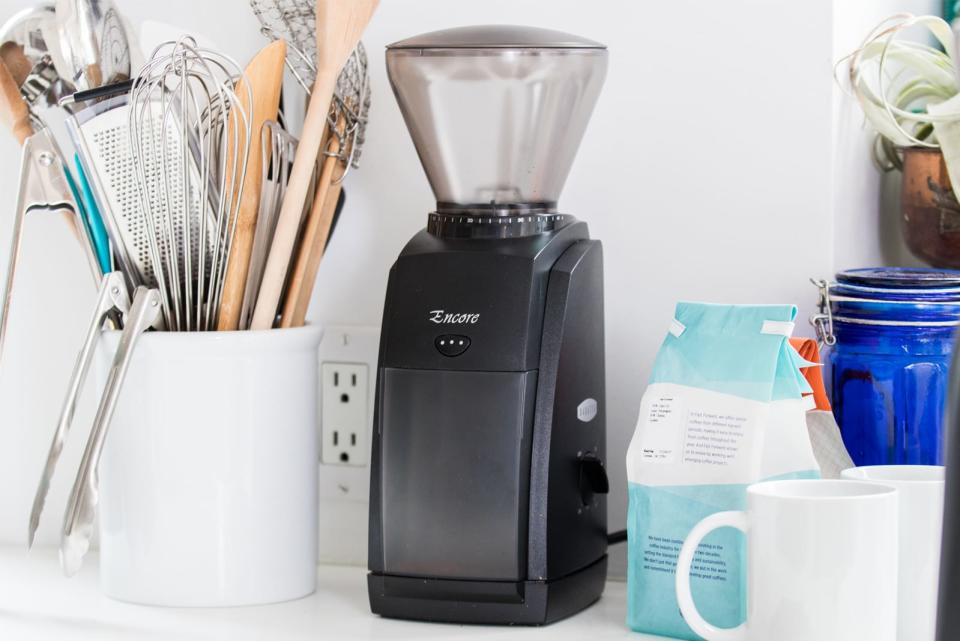
The slim and trim Baratza Encore is lower priced than most of the competition—at about $140 versus about $200 for anything else in its echelon—and it performs as well as or better than any home grinder we tried. While Baratza offers a range of somewhat similar grinders (from the Encore to the Virtuoso to the Vario) at different feature levels and increasing price points, we found the entry-level Encore to be the best grinder with the best features for most people. It grinds beans quickly and evenly, is simple to use and adjust, and is easy enough to clean and maintain that you'll use it for years to come.
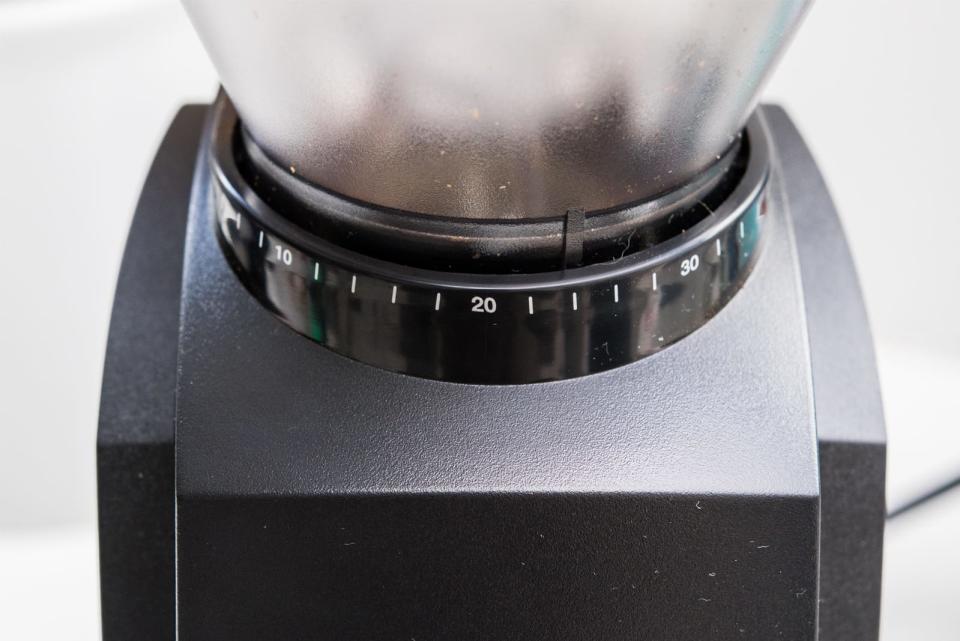
While it's physically inescapable that even the most consistent burr grinder will produce at least some amount of particles smaller and larger than the target grind size, we found the Encore performed best at grinding evenly. Using the Kruve sieve set to measure the amount of oversized and undersized particles created on a medium grind setting, the Encore hit the target best of all the home grinders we tested. The professional-grade Mahlkönig EK43 yielded a more uniform grind than anything else, but the Encore (along with the Virtuoso) came closest. As expected, the grinder that produced the most consistent grinds also produced the best-tasting coffee to our panel, results that were also corroborated by Counter Culture's coffee refractometer. The coffee we brewed with the Baratza Encore had an extraction percentage of 19.53 percent—right on the money, and the best of all the grinders we tested (with the Virtuoso a very near second)—and a TDS measurement of 1.32 on our very first try.
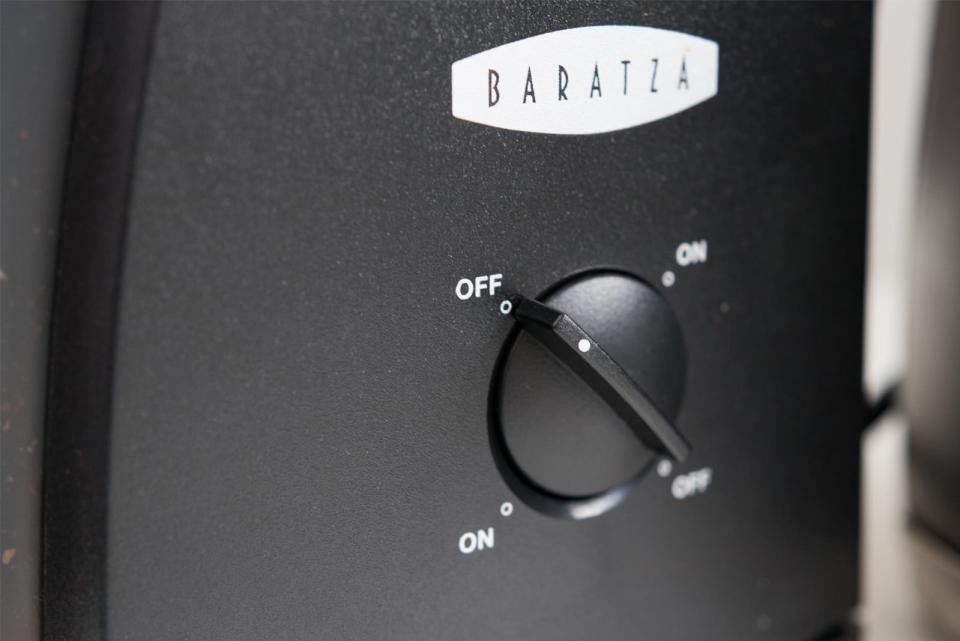
All of this underscores how impressed we were with this grinder for making it supremely easy to produce a great cup of coffee. Absent the bells and whistles of nearly all the competitors we tested—like the built-in scale on the OXO Barista Brain or the precision of the Breville SmartGrinder Pro—the Encore boasts only a modest on/off (actually it's on/off/on/off) toggle dial on the side and push-down pulse button on the front of the machine. But we don't see its simplicity as a real drawback. Other machines we tested, like the Breville SmartGrinder Pro, were confusing, with dials and digital settings that were unintuitive or overly detailed (the Breville has 60 different grind settings and a timer that measures fractions of seconds). The Encore, on the other hand, is easy to use and more than sufficient for the average home coffee drinker.
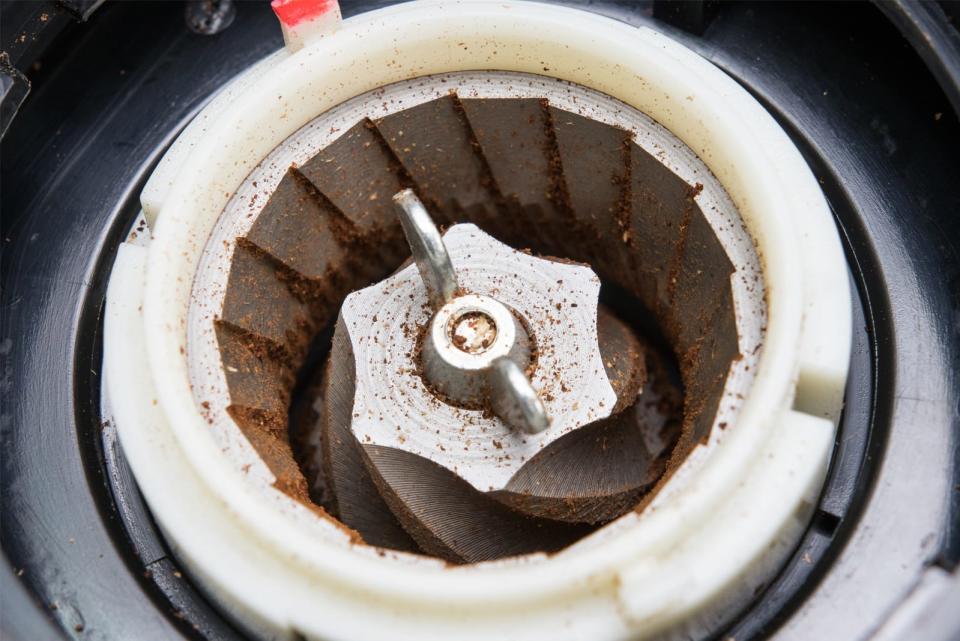
You can adjust the grind size easily on the Encore by turning the hopper to the preferred tick mark (measured in numbered intervals from 0 to 40, 40 being the coarsest) on its base, allowing you to quickly move from setting to setting and remember your preferences—generally a common feature among the grinders we tested except the Krups, whose intervals between grind settings were inconsistently sized. It took us 30 seconds to grind 68 grams of medium-grind coffee appropriate for filter brewing—enough to make several servings, depending on your coffee machine's interpretation of the word "cup." This speed fell about in the middle of the other grinders we tested at this setting.
With the hopper removed, it's easy to twist the top burr out of the Encore for easy cleaning and maintenance. And when the time comes to replace the burr set (which the manufacturer recommends after 500-1,000 pounds of coffee), it's easy to order the part from Baratza's website. A limited one-year warranty is available for this and all Baratza grinders, provided you keep up regular maintenance and cleaning and don't use the machine to grind rocks or something. Beyond that, Baratza has a great reputation for durability and customer service. We've been using the Baratza Virtuoso (our upgrade pick, which is similarly built) daily in the Wirecutter test kitchen for the past two years, and it shows no signs of wear. But if your machine does break out of warranty, you can send the Encore to Baratza for repairs (which come with their own six-month warranty) for $45 at the time of writing.
Ultimately, the fact that both Baratza's Encore and Virtuoso (our upgrade pick, below) came out on top was not a huge surprise to any of the coffee veterans we chatted with. Unlike the other companies whose electric grinders we tested, Baratza is the only outfit to specialize exclusively in coffee grinders. "At home, I think a lot of people just look to brands they know, and the problem with that is those people don't make coffee equipment, that's not their thing," says Ramage. Baratza, it appears, continues to do something right.
Flaws but not dealbreakers
The Encore takes a long time to grind on a very fine, espresso-like setting. But for most people brewing traditional filter coffee at home without the rigorous demands of espresso, this will not be a concern.
The Encore is also the simplest machine we tested; it lacks special features. In particular, there's no way to close the bottom of the hopper that funnels whole beans down through the burrs. So in order to change out coffees while beans are still in the hopper, you have to invert the entire machine over a bowl to empty it out—if you simply remove the hopper, beans will pour out the bottom and all over the counter. But that's something the Encore has in common with almost every grinder we tested (except the OXO Barista Brain), so we don't see it as a dealbreaker.
The Encore only has an on/off switch, so it doesn't allow for a timed grind (which the Baratza Virtuoso does). A timer would allow you to turn on the machine and walk away knowing you were grinding the right amount, which is convenient for busy mornings but not essential, since grinding enough coffee for a full pot takes under a minute. It would also be nice if, like some other grinders, the Encore included a built-in scale for measuring how much coffee you grind more precisely. Overall, none of the Encore's missing features cause enough inconvenience to offset the overall quality and ease-of-use of this workhorse grinder.
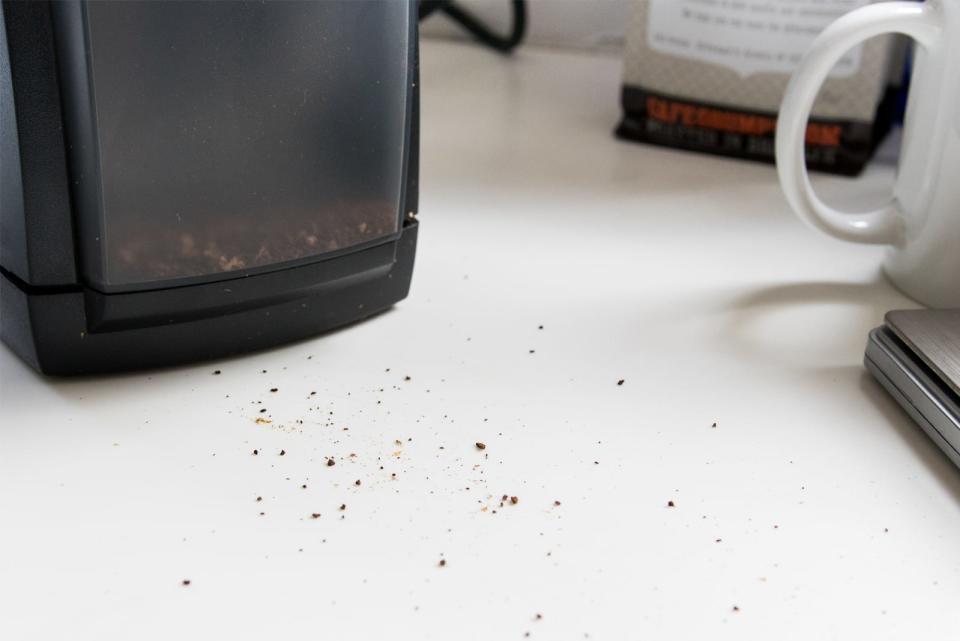
Finally, grinding coffee can sometimes be messy. Static builds up, and when you remove the drawer of grounds from the Encore, some dust and chaff will spray onto the counter. This is a result of a combination of factors: the humidity of the room you're in, the type and age of coffee you're grinding, the materials used to make the grinder and grounds hopper, the grind setting you've selected, and even what kind of surface your grinder sits on. Dry environments produce more static, while lighter roasts produce more chaff than darker, oily ones. Some of our team found the Baratza Virtuoso produced a lot of staticky chaff, but others found the Baratza series of grinders to be relatively inoffensive in this regard. In any case, the Baratza machines were no worse than any other machine we tested, so it's not a dealbreaker. For those who have an ongoing problem with static and grounds, prevailing wisdom is to simply wait a minute before removing the grounds chamber from the grinder, allowing the dust to settle, as it were.
Upgrade pick: Baratza Virtuoso
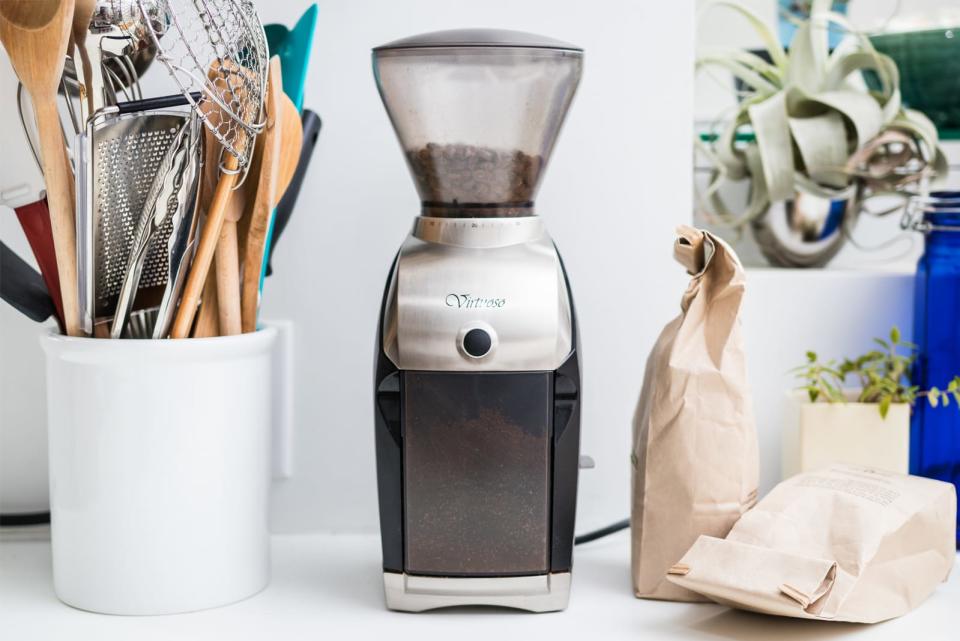
If you're willing to pay more, the Baratza Virtuoso is a nearly identical grinder to the Encore, but it has a slightly speedier burr set, a timer-switch on the side, and a heavier base that helps the grinder stay in calibration. In a previous version of this guide, the Virtuoso was our top pick, but in more recent testing, we found the grind consistency comparable to that of the Encore. So, since you're paying more for the features rather than the performance, we think it's only worth the investment for serious coffee lovers.
The Virtuoso is also a little better-looking than the Encore, with a cast zinc body that may complement modern decor better than the simple matte black Encore. But none of its extra features was enough to convince our team to recommend a nearly hundred-dollar-higher spend over the Encore. While it's a little more convenient for repeatability to have a timer switch instead of one you flip on and off, that timer is still somewhat vague: there are no numbers or time increments indicated, just different thicknesses of lines. Absent the (theoretical) precision of actual countdown timers like on the OXO On grinder or Breville SmartGrinder Pro, this added feature on the Virtuoso is good but not great.
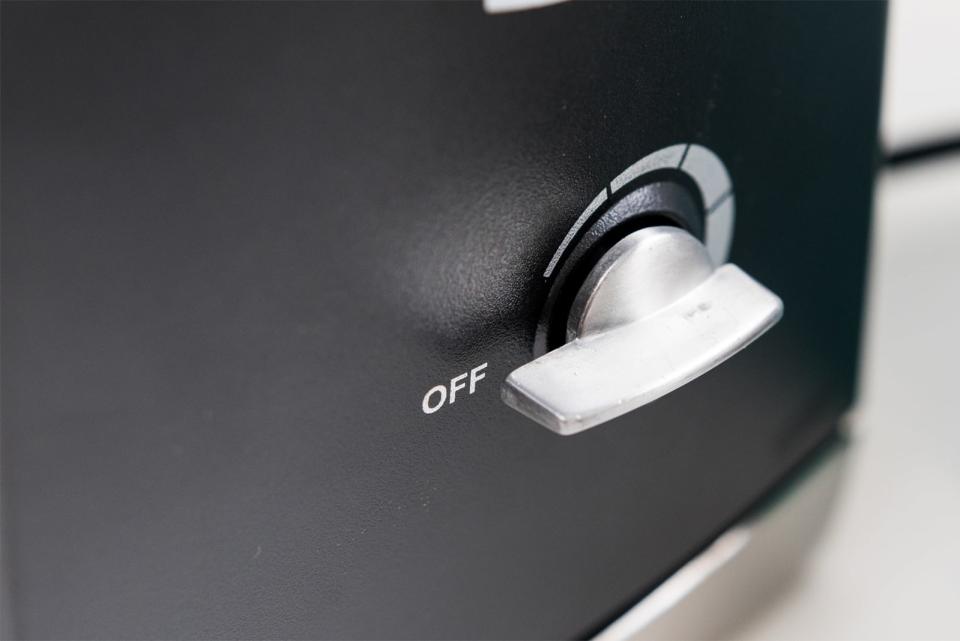
But if you're a power-user—someone who intends to grind a lot of coffee every day and really puts their machinery to the test—the sturdier base may make a difference in the long run for you, as you will need to readjust your grind calibration less frequently. "The biggest problem with home grinders is there's enough force created by the beans being ground will shift the alignment," says coffee writer Scott Rao, noting that professional-grade grinders in coffee shops are notoriously heavy for just that reason. "The fact that you have this plastic housing and a shaft that has a lot of force going on, the shaft will always shift." Like the Encore, you'll be using another method of measurement (time or an external scale) to measure your precise coffee dose, as the Virtuoso doesn't grind by weight. But also like the Encore, it's very cheap and easy to replace the burrs. The Virtuoso also comes with a limited one-year warranty, and beyond that, can be sent back to Baratza for repairs for $60 at the time of writing.
Budget pick: OXO Brew Conical Burr Grinder
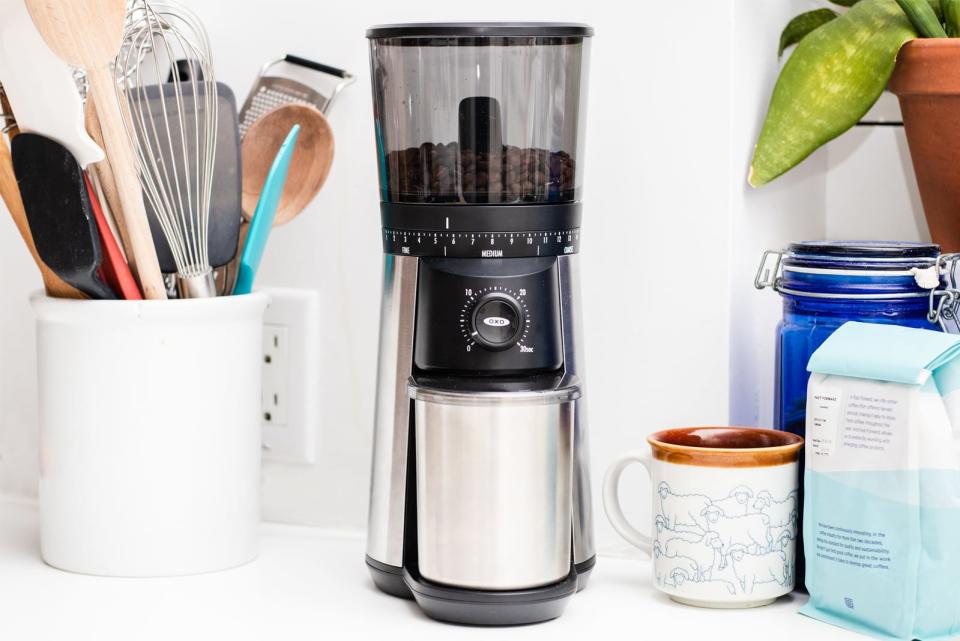
If you really don't want to spend more than $100 on a coffee grinder, the OXO Brew Conical Burr Grinder is just the ticket. Usurping our long-running former budget pick, the Capresso Infinity, the OXO is a function-rich, capable grinder with consistent and speedy performance. While it doesn't grind quite as evenly of finely as the Baratzas, it does come with a wider and more nuanced range of settings than the Capresso. Like the Capresso, the OXO can't produce a fine enough grind for espresso, but for an average person's daily drip needs, it's a great machine for the money. And it comes with some nice extra features, like a timer, a removable hopper, and a mechanism to help reduce static build-up as your coffee grinds.
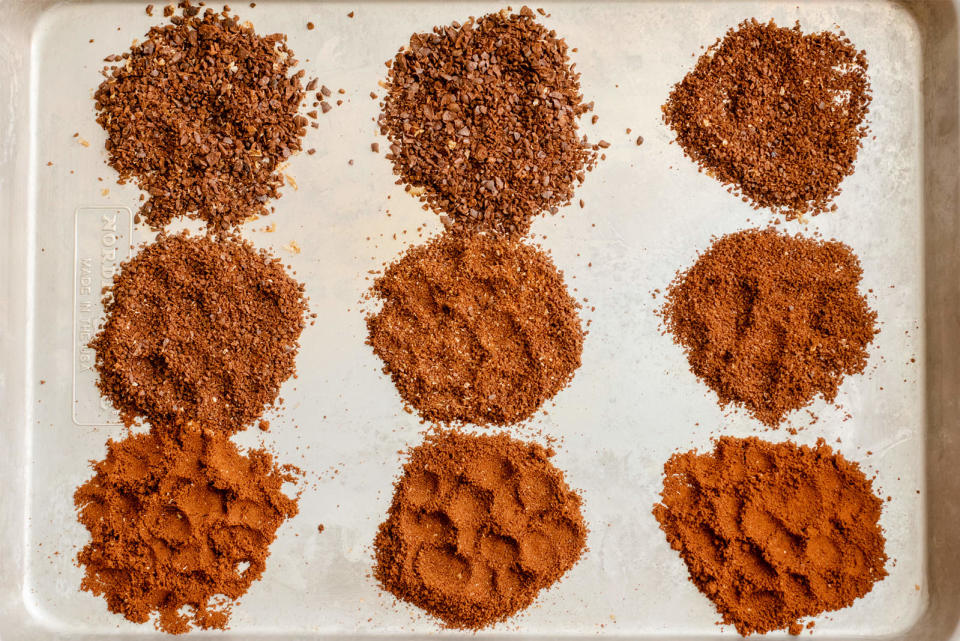
The OXO's simple, intuitive design and consistent performance both helped put it at the top of our budget ranks. Grind consistency at medium grind settings was nearly on par with our top picks (with its coarsest grind being the least consistent and very, very boulder-filled), but it wasn't able to grind as finely as our top picks. When we sifted 10 grams of grounds from first the OXO, then Baratza Encore in the Kruve sifter, the OXO yielded about 4.9 grams of coffee ground to the target optimal size, while the Baratza yielded 5.1 grams; the Capresso yielded only 3.8 grams of coffee ground to the target size.
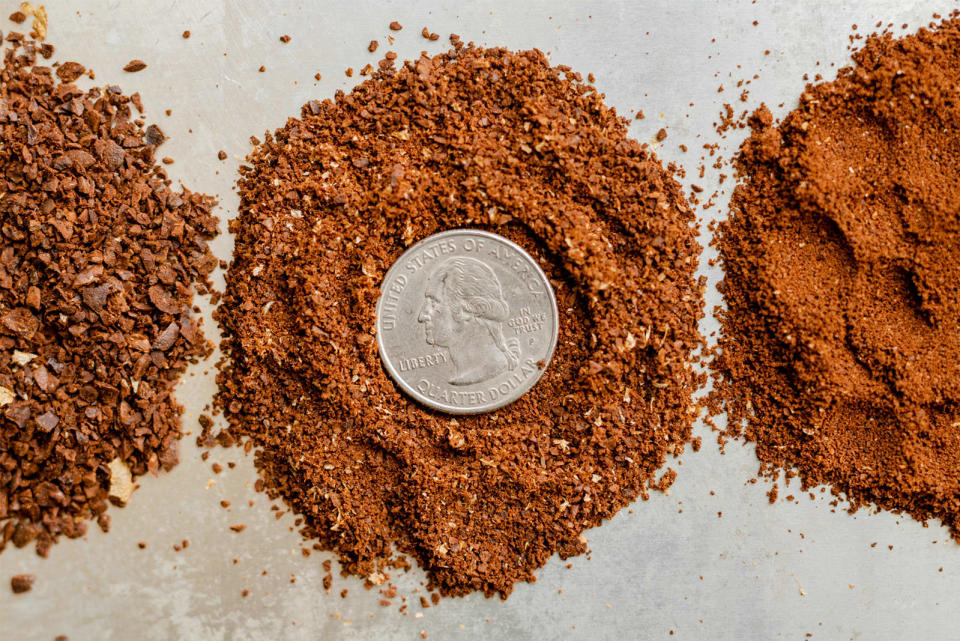
The OXO is speedy, too, grinding nearly 10 grams more coffee in a 15-second interval than either the Baratza Encore or the Capresso. We also liked that the OXO offered a much wider range of discernible grind sizes than does the Capresso, which puts out a fairly narrow range of grinds despite where the somewhat vague dial is set.
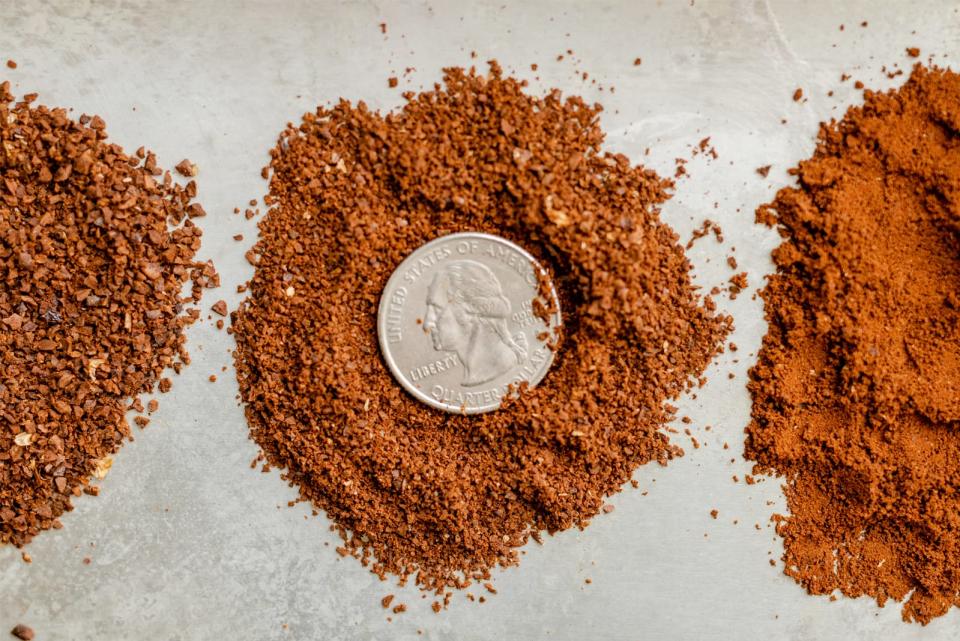
We liked the OXO for many other reasons, too, not the least of which is the removable hopper, a feature that few home coffee grinders have. For those whose lifestyles require the occasional coffee switch-up (to decaf, another roast, or something fresher), this handy feature allows you to remove a hopper with beans still in it to switch or empty it out, rather than invert the whole darn machine over a bowl (as you have to do with the Baratzas).
And unlike most coffee grinders, the markers on the machine actually appear to make sense—the grinding timer times (more or less) in actual seconds marked, and the grind setting markers offer a wide span of small, easy-to-read increments, making small adjustments uncomplicated work. In contrast, the timer on the Baratza Virtuoso lacks numbers, while on the Capresso machine, the numbers on the timer appear to relate to clock time, but actually operate in a temporal reality all their own. The Capresso's grind settings, meanwhile, are marked by broad, imprecise tick marks.
The grinds canister on the OXO Brew is a huge improvement over the one on OXO's more expensive grinder, the OXO On Conical Burr Grinder, which we quickly disqualified for spraying coffee all over the counter. The OXO Brew's canister sits snugly below the exit chute, neatly catching all the grounds.
OXO has also designed a mechanism to help reduce static build-up as the coffee grinds, an issue we encountered with other models often in our testing. As an OXO representative explained it: "We found that the best way to dissipate static is by electrically grounding the steel Grounds Container through contact with a steel tab on the Grinder body. The steel tab is then connected to the ground plug on the power cord. This provides a direct path for the static electricity stored in the grounds to dissipate." In our testing, this feature made for a cleaner grinding experience, though it doesn't completely eliminate static. We'll continue to long-term test to see how well it works with different coffees under different conditions. We also like that the shape of the canister makes it super easy to pour fresh-ground coffee into your filter.
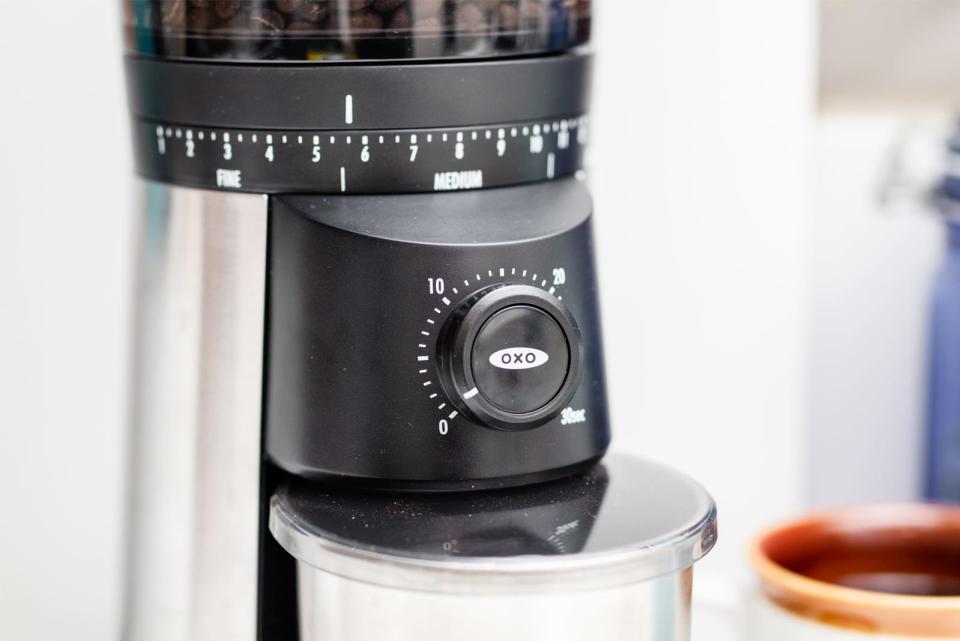
One thing we didn't like about the OXO was its weight: It's over a pound lighter than the Baratza Encore and two pounds lighter than the sturdy Capresso Infinity. Ideally, a grinder will be hefty enough to reduce vibration (or potential counter-scooting), which can contribute to having to more frequently readjust one's grind setting as the burrs slowly jostle out of alignment. We'll keep an eye on this feature in long-term testing, especially as we grind lighter-roast coffees which will be harder work on a machine.
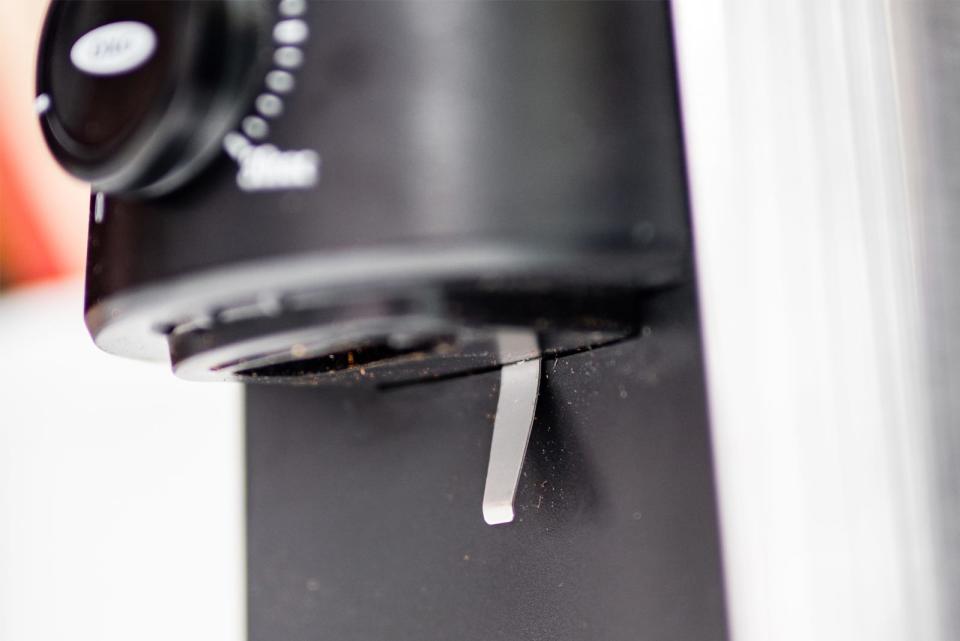
We also realize that $100 isn't that cheap for a budget grinder. We tried hard to help casual coffee brewers break down the price barrier by looking for a decent, functional burr grinder closer to $50 than $100. But after testing the Krups GX-5000 and the Cuisinart CBM-18N, we can't recommend anything much cheaper than $100. The OXO doesn't offer an enormous cost savings over our top pick, the Baratza Encore (which still outperformed it), but if you really can't bear to break $100, it's your best bet. It was consistent enough to rival our top picks, while the Krups produced a grind so uneven, the difference was visible to the naked eye before even sifting with a Kruve. The Cuisinart grinder fared slightly better but lived up to our overall first impression of its flimsy construction when the handle for lifting out the burr snapped right off in our hands. The OXO, conversely, feels sturdy (if a little light) and significantly more durable than any other machine in that price range besides the Capresso.
The OXO grinder comes with a two-year warranty, during which time OXO will repair or replace your machine. Unfortunately, unlike Baratza, the company does not sell burr replacements (although the top burr is removable for cleaning), so you're out of luck if you need new burrs outside of the window of the warranty.
Also great: Porlex Mini Stainless Steel Coffee Grinder
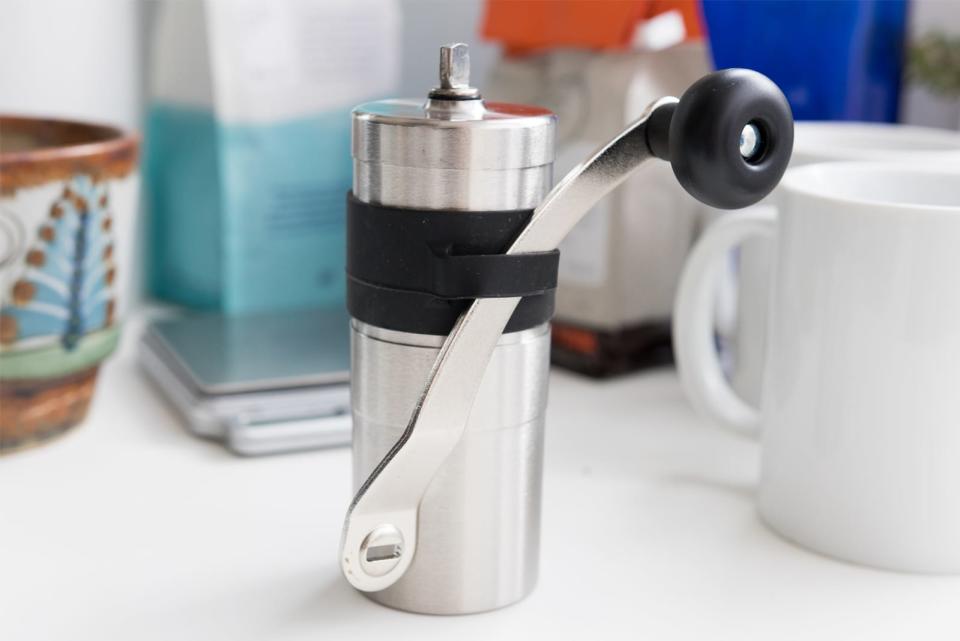
For those in the market for a truly portable hand grinder for travel—or a nice forearm workout—we recommend the Porlex Mini. The two models we looked at, the Hario Mini-Mill and the Porlex Mini, both feature high-quality ceramic burrs, but the latter came out way ahead.
Don't expect to use the Porlex as an affordable alternative to an electric grinder, especially if you ever want to brew more than one cup at a time.
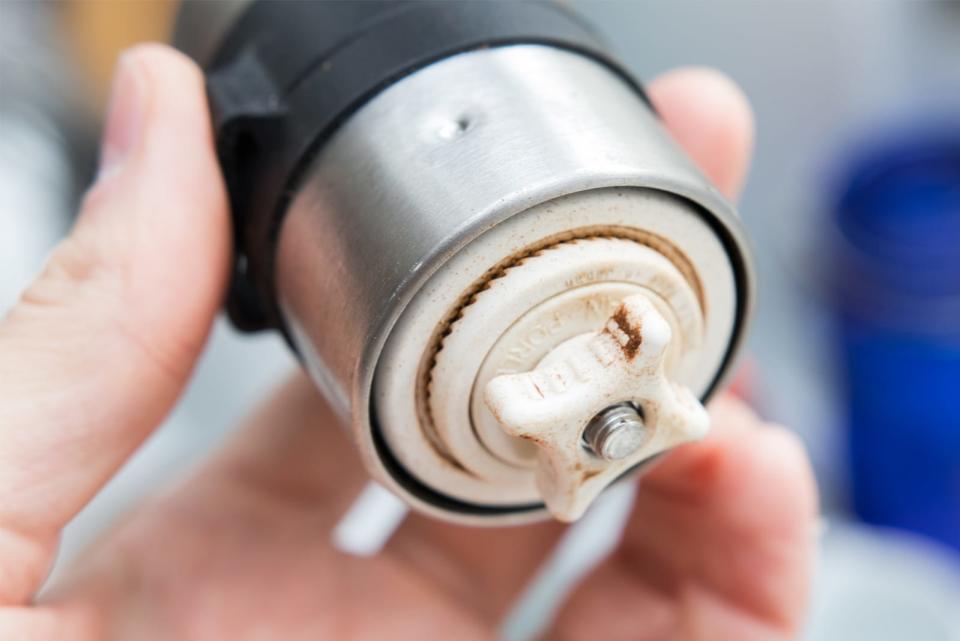
With a smaller profile, the Porlex is easier to hold. The hand-cranking action is faster and smoother, and beans appear to drop down at a more rapid rate than in the bulkier lucite Hario. The Porlex is also made of stainless steel, meaning it won't crack when dropped like the Hario. And if that all wasn't enough to vouch for it, traveling and camping brewers will love how it fits perfectly inside the chamber of an AeroPress brewer for compact packing.
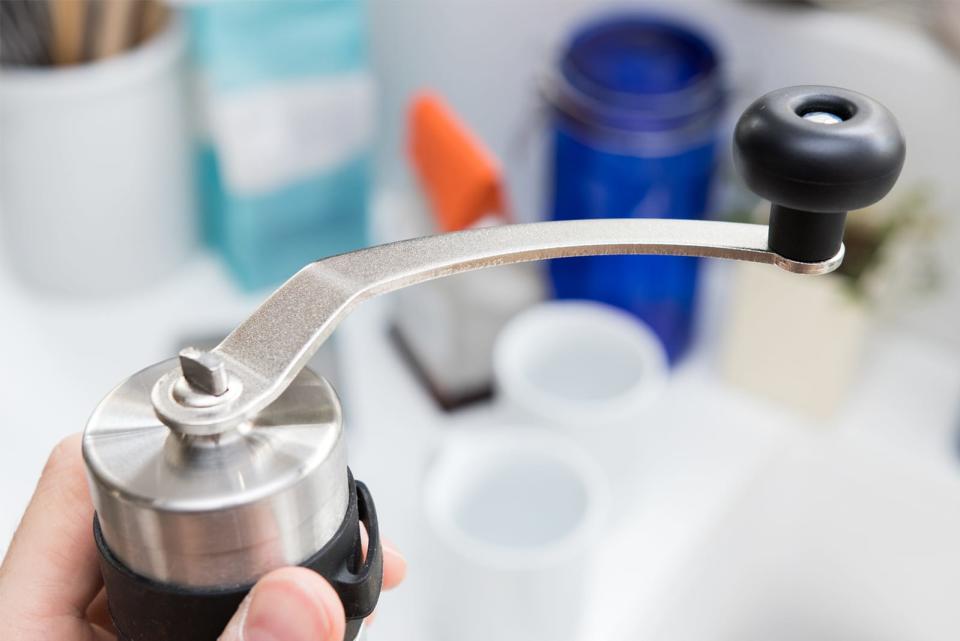
At grind speeds that feel glacial (particularly if you're grinding the first cup of the day), we can't recommend a hand grinder as an everyday tool to be used instead of an electric grinder. "What I hate about hand grinders is that many of them, it takes minutes to grind one cup of coffee because they don't have any way to force the beans down into the burrs," says Rao. "Basically you can stand there with a hand grinder for 10 minutes and not get 20 grams of beans to go through. My brother-in-law even put a drill on one once, and we couldn't find a drill speed that would do it."
So, don't expect to use the Porlex as an affordable alternative to an electric grinder, especially if you ever want to brew more than one cup at a time. But there is a time and a place for a good manual grinder: when you aren't preparing very much coffee to be served at once, and when you are traveling either to a grinder-less, coffee-shop-free location or spending a long period of time in the great outdoors. In those circumstances, the Porlex will make the grinding process easier, if not effortless.
The competition
Our previous budget pick, the Capresso Infinity, is a fine choice for its price, just under $100. The Infinity did well in our tests, though it's better at grinding coffee into very fine particles than into coarse ones, and we found the usability a bit arbitrary, with the numbers on its timer switch indicating some duration of time that isn't seconds. It has a heavier base than the OXO Brew Conical Burr Grinder and a pretty small countertop profile, which may appeal to some. But ultimately, we found the OXO to have a better range than the Capresso and a better set of extra features like an accurate timer and removable hopper.

We tested the Krups GX5000 because it came recommended by Business Insider as an under-$50 budget pick, but it was notably flimsy, loud, and imprecise. We found the sound of its motor annoying, but not as annoying as how inconsistent the grinds it produced were.
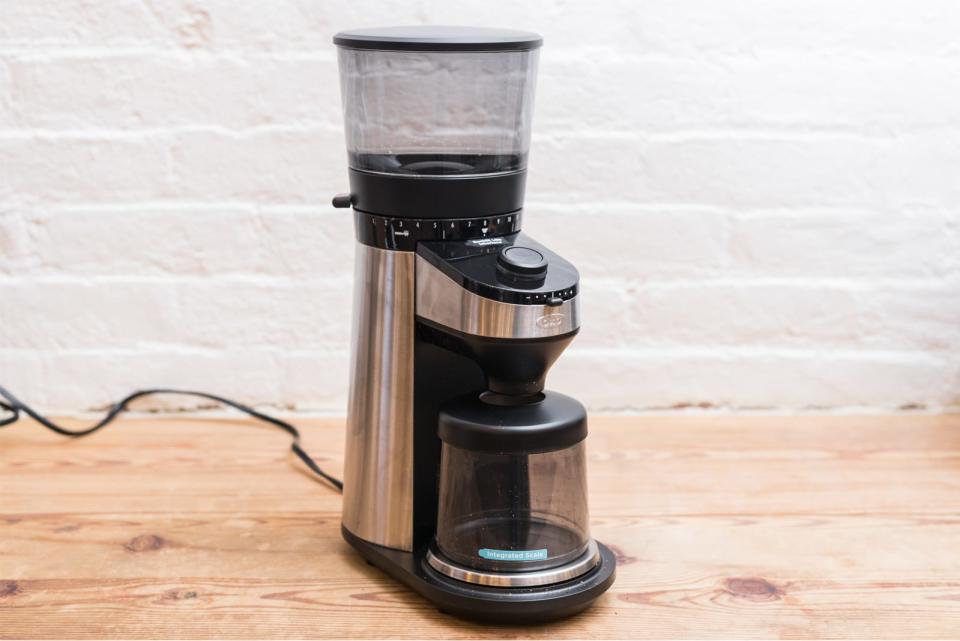
The OXO Barista Brain looked great on the counter, had a handy integrated scale and dose-by weight, and sported a simple and friendly interface—check out that much-hyped backlit dial! But it disqualified itself almost immediately by spewing seemingly endless coffee chaff all over the countertop each time we used it, despite testing it in various settings with various coffees. What a mess.
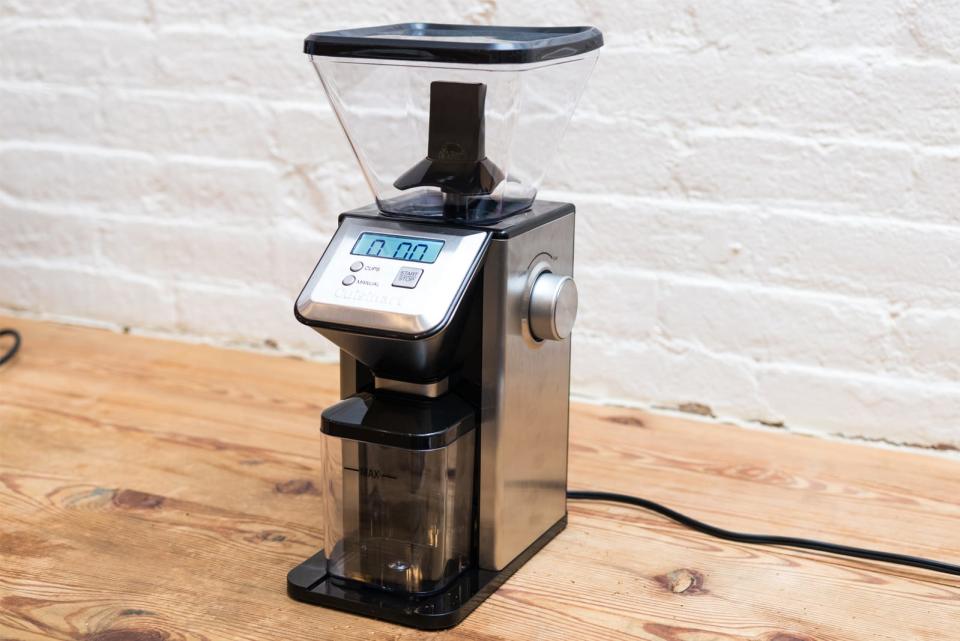
The Cuisinart CuisiPro CBM-20 seemed promising at first—if rather large—but its lightweight feel and unintuitive interface were quickly off-putting. Its grind size tended coarse, and we found measurements to be inconsistent. Lastly, the upper burr's handle snapped off in our hands when we tried to remove it for routine maintenance.
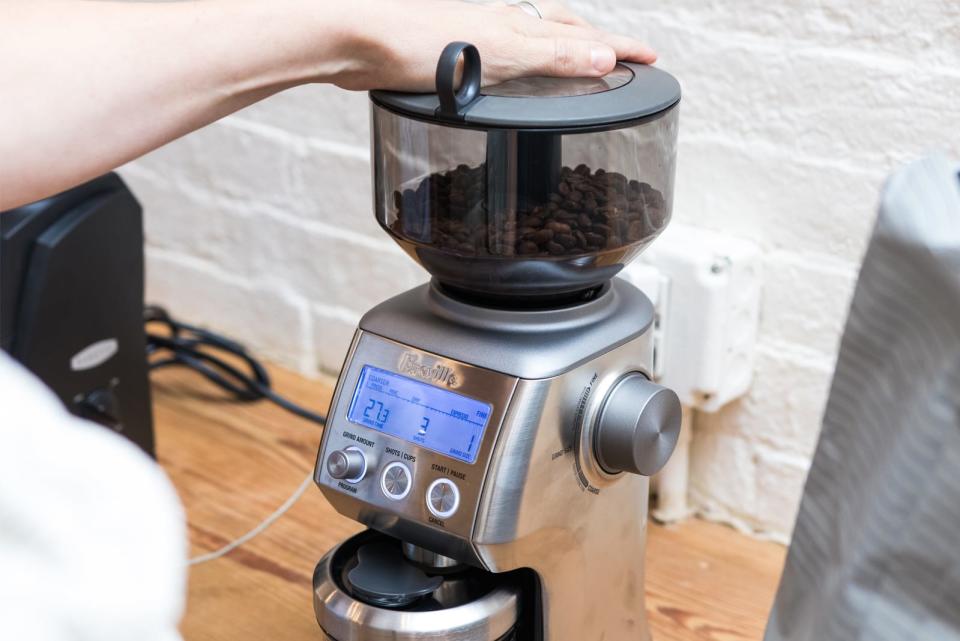
We tested the Breville SmartGrinder Pro, intrigued by its encyclopedic list of options and features. But the abundance of settings—timed dosing down to 0.2-second increments and up to 60 different grind sizes—and complicated digital interface made it difficult to use. It took forever for us to dial in, and our tests produced over-extracted batches each time.
We also considered upper-level Baratza models like their Sette, but ultimately decided the price tag and feature set were both above and beyond the scope of most people's needs.
The Hario Mini-Mill was one of our two hand-grinder candidates, but despite its quality ceramic burrs, it simply took too long to grind a cup of coffee to recommend.
This guide may have been updated by Wirecutter. To see the current recommendation, please go here.
When readers choose to buy Wirecutter's independently chosen editorial picks, Wirecutter and Engadget may earn affiliate commissions.
